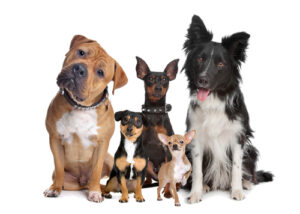One of the most important aspects of being a successful dog groomer is maintaining professional standards at all times. Clients trust their beloved pets to groomers, so they need to be sure that the person  in charge of grooming and caring for their pet is knowledgeable and capable of the task at hand. The groomer must display professionalism at all times, and that starts with the very first meeting with the client and their dog. One major component of professionalism is industry knowledge and a passion for the field. This is demonstrated when groomers can recognize and identify different types of dog breeds immediately upon meeting a dog.
in charge of grooming and caring for their pet is knowledgeable and capable of the task at hand. The groomer must display professionalism at all times, and that starts with the very first meeting with the client and their dog. One major component of professionalism is industry knowledge and a passion for the field. This is demonstrated when groomers can recognize and identify different types of dog breeds immediately upon meeting a dog.
Recognizing Different Types of Dog Breeds
If you can accurately name a client’s dog breed when you first encounter them, the client will be much more assured that you will deliver a quality grooming experience that meets breed standards for their pet. Clients with purebred pets are generally enthusiastic about their particular choice of breed and are well-versed in that breed’s grooming standards.They will want to be confident that the groomer they have chosen will be capable of delivering a clean, well-executed cut that adheres to established standards for their breed.
Clients who own mixed breed pets will also need to be assured that their groomer is capable of mixing and matching different cut styles and techniques to deliver a final product that is modified to best fit and flatter their dog.
Professionalism and Quality
Recognizing different types of dog breeds or mixed breeds immediately upon meeting clients goes a long way toward establishing a good client-groomer connection and maintaining professionalism. It also helps the groomer to complete each job quickly while maintaining quality, as oftentimes, the grooming techniques necessary for a job depend on the pet’s breed. For example, hand stripping should be done on most terrier breeds, with the exception of four: the Bedlington terrier, the soft-coated Wheaten terrier, the Kerry Blue terrier, and the Cesky terrier. An experienced dog groomer should be able to recognize these different types of dog breeds and immediately identify whether or not the hand stripping technique is appropriate, for example.
Breed Standards
Different types of dog breeds require different grooming techniques because of the long history of breed standards and how they developed. The American Kennel Club recognizes hundreds of different breeds of dogs.
The history of breed standards began around the nineteenth century, according to The Kennel Club. Dogs were first bred to have certain characteristics, temperaments, and physical builds, primarily to perform different jobs, such as hunting, herding, or sporting. For example, poodles were traditionally bred to hunt and retrieve waterfowl. Their thick, curly coat is resistant to water and only single layer, making it ideal for a dog that’s in and out of the water (it doesn’t get waterlogged as easily and makes for faster drying.) However, this type of coat can result in significant matting and requires special techniques to properly groom, such as force drying on 50% to leave the coat slightly damp for fluff drying.
This is only one example of how breed standards and the history of different types of dog breeds impacts grooming standards for them today. While most dogs are no longer used for their original working purpose, and they are more commonly owned as pets and companions today, their original breed standards and purpose still affect how they should be groomed. Many different types of dog breeds are groomed to accentuate their unique qualities.
Providing an Excellent Grooming Experience
Recognizing different types of dog breed has a few benefits for groomers. Identifying the type of dog you are grooming will help to determine the cut pattern they need, which techniques to use to achieve it, and how the dog should look overall at the completion of the process. Having an in-depth knowledge of different breeds and their grooming standards will assist the groomer in delivering a quality cut for purebred dogs. It will also help with the grooming of mixed breed dogs because it will help the groomer to select different classic cuts to mix and match for each dog to develop the most flattering style.
In addition to helping determine proper grooming techniques, being able to identify different types of dog breeds helps the groomer to connect with the client and instill trust and confidence in their grooming skills. Dog owners are passionate about their pets, and groomers should demonstrate this same level of passion for their craft.
At Merryfield Academy, we teach students proper grooming techniques for many different types of dogs, including mixed, terrier, non-sporting, drop coat, and miscellaneous breeds. If you want to become a groomer with high-quality training and experience, contact us today at 954-771-4030 for information on application and enrollment.
Sign up for
Free Career Report
"*" indicates required fields
